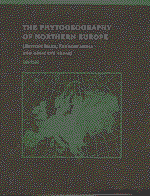Book contents
- Frontmatter
- Contents
- Preface
- Acknowledgements
- 1 Introduction
- 2 Climate
- 3 Edaphic factors
- 4 The geological history of the present European flora
- 5 The atlantic and oceanic elements
- 6 The thermophilic element
- 7 The boreal element
- 8 The arctic, alpine and montane elements
- 9 Endemic, disjunct and centric distribution patterns
- 10 Anthropochorous plants
- Appendix I Calculation of climatic parameters for comparison with plant distributional data
- Appendix II The Northern European species of Flora Europaea with indications of their status and climatic correlations
- Appendix III Arctic species of vascular plants
- Appendix IV Endemic species of vascular plants, bryophytes and lichens
- Appendix V Extra-European disjunctions – bryophytes and lichens
- References
- Index
8 - The arctic, alpine and montane elements
Published online by Cambridge University Press: 23 October 2009
- Frontmatter
- Contents
- Preface
- Acknowledgements
- 1 Introduction
- 2 Climate
- 3 Edaphic factors
- 4 The geological history of the present European flora
- 5 The atlantic and oceanic elements
- 6 The thermophilic element
- 7 The boreal element
- 8 The arctic, alpine and montane elements
- 9 Endemic, disjunct and centric distribution patterns
- 10 Anthropochorous plants
- Appendix I Calculation of climatic parameters for comparison with plant distributional data
- Appendix II The Northern European species of Flora Europaea with indications of their status and climatic correlations
- Appendix III Arctic species of vascular plants
- Appendix IV Endemic species of vascular plants, bryophytes and lichens
- Appendix V Extra-European disjunctions – bryophytes and lichens
- References
- Index
Summary
Arctic plants have their main distribution north of the arctic timber-line. Alpine plants have their main distribution above the climatic alpine timber-line. Montane plants have their main distribution in high-lying forests in the southern part of their area but can occur at low elevations in the north. Their lower distribution limits fall from the south towards the north and generally from continental to oceanic areas. Many otherwise alpine species can be found at sea level along the west coasts of the British Isles and Fennoscandia.
The alpine and montane plants have a distribution approximately the inverse of the thermophilic plants. Since the upper and northern limits of the thermophilic plants are related to summer temperature, the lower and southern limits of the alpine plants must be negatively related to high summer temperatures. The question is, what are the physiological mechanisms responsible for these distribution patterns.
One obvious explanation is competition (Pigott 1978). Alpine and arctic plants are low-growing and hence unable to compete for light where climate is favourable for tree growth. This hypothesis can easily be tested by planting alpine species in botanic gardens in the absence of competition and observing whether they survive. Often they do quite well, but not always. Some species are hard to keep outdoors for many years in botanic gardens. Very often they survive the spring but seem to suffer in the summer heat. They have a better period in autumn and next spring, but after a few years they are so weakened that they die.
- Type
- Chapter
- Information
- The Phytogeography of Northern EuropeBritish Isles, Fennoscandia, and Adjacent Areas, pp. 93 - 109Publisher: Cambridge University PressPrint publication year: 1998



